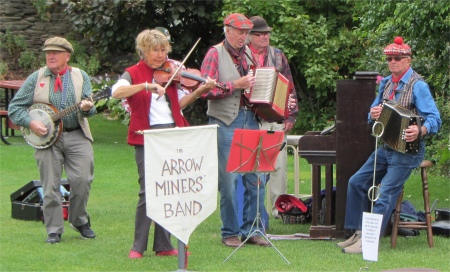
Arrow Miners Band Celebrating 150 Years of Mining in the Town
|
I made my way up to the ski centre on Coronet Peak to get one last view across the basin, before heading down to Arrowtown. Because of my coal mining roots, and the pleasure I had derived from exploring the copper and gold mining areas in Montana and California in 2010, I was drawn like a magnet to Arrowtown.
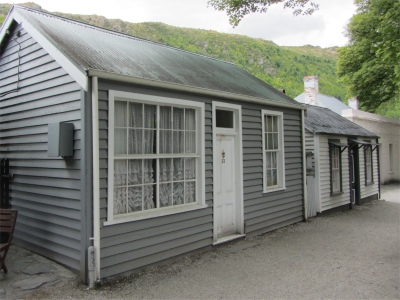
Arrowtown Miners Cottages
|
There was some debate as to whether it was American William Fox who first discovered alluvial gold in the Arrow River in 1862, but he seemed to have dominated the area for a while, the town even bore his name until Foxes gave way to Arrowtown. The Arrow River became known as the richest for its size in the world, which in turn drew scores of prospectors, including Chinese. At the height of the gold rush the population reached 7000. Similar to the Californian gold rush, the Chinese formed their own settlement, and were down trodden. When gold was discovered on the west coast, hoards of prospectors headed across to Greymouth and Hokitika, leaving the Chinese to pick over the tailings left by the European miners.
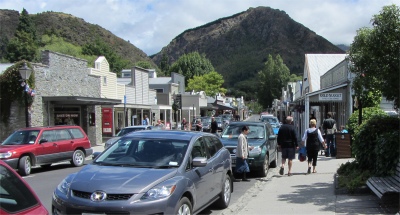
Downtown Arrowtown
|
Today, this former gold-mining settlement sat lazily below the Crown mountain range. Pretty streets, lined with sycamores and oaks imported from Europe and planted in the 1860s, contain sixty or so tiny miners' cottages, built in the late 19th century. Businesses such as hotels, saloons, gambling dens and dance halls had once flourished here. Through careful preservation, the legacy of the early settlers is retained in a fascinating, picturesque town where the past and present are delightfully blended.
The Lakes District Museum gave an insight into the area's chaotic past, the lives of the miners and their families, including the Chinese community. They were mighty tough those early pioneers. The complete community was represented in the museum: butcher, baker, blacksmith, school, doctor, carpenter, printer, brewer, inn keeper etc. In the early days, it was those who ran the service industries who became rich rather than the miners.
As I made my way to the Chinese Settlement, a voice called out, "Hi, Dave." Were they calling me, who on earth knows me around here. I turned around and it was Pipa who I had met with her husband in Invercargill and the Clifden Suspension Bridge. They had more or less tracked a similar itinerary to me, and we had actually stayed at the same campsite in Queenstown, though we had completely missed each other there. They were now off to Wanaka, and would have to make a decision there as to whether to go up the west coast or head inland. They needed to return their van to Christchurch in six days' time, so it was a difficult call for them. We swapped stories of our most recent activities before parting; she to the pie shop and me to the Chinese Settlement.
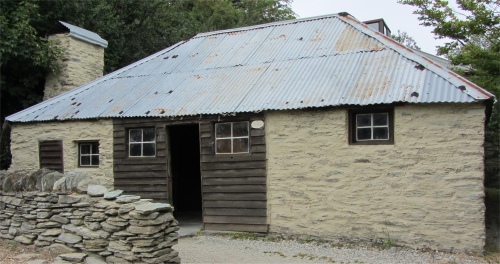
Reconstructed Al Lum's Store
|
The Arrowtown Chinese Settlement was the best preserved of New Zealand's Chinese communities. Here the buildings had been originally constructed of tin, sod and timber, and not many were left standing when an archaeological dig began in 1983. Restored huts and shops, the ruins of a cottage with its wild plot of daffodils and briar roses, a primitive stone hut on the riverside help to provide a tangible story of the misery these souls had to endure.
I spent some time meandering up through this small, one-time community. The heart of the community would have been Ah Lum's store. Ah Lum, also called Lau Lei, was a respected community leader. His literacy in both English and Chinese enabled him to transact business deals and serve as an interpreter and letter writer. Chinese gold seekers used his store as an informal bank and a community meeting place where they could smoke, gamble and chat among friends. The loft also provided accommodation for visitors and travellers. The store stocked a variety of European and imported goods including Chinese teas, rice, pickled lemons, ginger, opium, gambling pieces, medicines and smoking accessories.
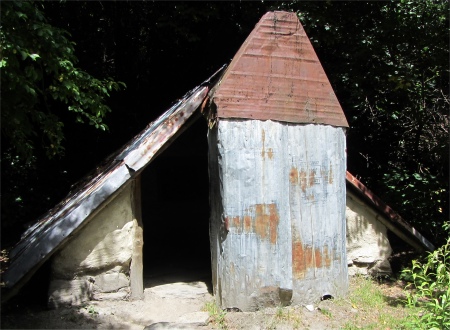
Kong Lum Building
|
Almost every Chinese gold seeker came from the Cantonese province of Guangdong in South China. Here, life for small farmers was a struggle for survival against over-population, unemployment, disease and political turmoil. The appeal to seek gold was irresistible. Compare the 1871 annual wage of NZ�12-14 for a labourer in Canton with that of an average Chinese gold miner in Otago who could earn up to NZ�77 a year, and save two thirds of it to take home.
Physical and emotional challenges extended beyond the search for gold. After Guangdong's near tropical climate, the newcomers would have been shocked by Otago's brutally cold winters and made anxious by local hostility towards them.
By 1865 Otago's first gold rush was already over and thousands of European gold miners were leaving for new, West Coast goldfields. Fear that the province's economy would collapse persuaded the Provincial Council to invite Chinese miners to come to Otago from the Australian goldfields. Opposition was countered by the argument that an "
increase in population, even were it in the shape of chimpanzees, would be preferable to no population at all." By 1871 Chinese outnumbered European miners on the Wakatipu goldfields.
There were mixed views on the Chinese population. Here are some press cuttings about the Chinese:
"Temperate, frugal and well behaved" -
Otago Witness 1865
"It seems astonishing how these industrious people manage to get gold when everyone else has concluded there is none" -
Lake Wakatipu Mail 1870
"Almond eyed, leprosy tainted filthy Chinamen " -
Tuapeka Times 1885
"For the past week, Arrowtown has been the centre of attraction for about 200 Chinese, who have made night hideous with their exploding crackers, and their disgusting presence felt in more ways than one"
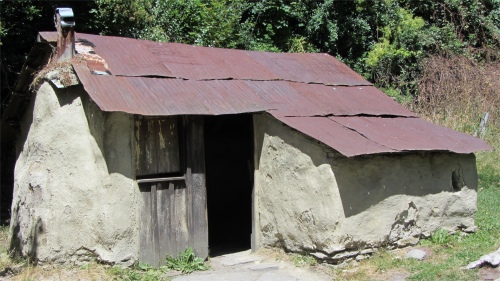
Old Tom's House
|
As their numbers swelled and their commercial interests expanded, the immigrants faced increasing resentment. European prejudice fed eagerly on vicious rumours of Chinese debauchery and disease, fuelling the fear that New Zealand could be colonised by an "inferior race". From 1881 the government introduced a series of laws to discourage Chinese immigration, culminating in a prohibitive entry fee of NZ�100.
The Chinese did their best to avoid trouble. They kept to themselves, living largely outside the European community and depending on each other for support. Many Chinese gold seekers were related by kinship, their passage assisted by New Zealand-based relatives in what became known as "chain migration".
By 1890 Otago's easily worked gold was well and truly exhausted and many Chinese miners moved on. Most returned to China, some went to West Coast goldfields, others found new work, particularly in market gardening. The main occupants of the Arrowtown Chinese Settlement became elderly men with limited means, living rather lonely lives. Old miners longed to be buried in ancestral cemeteries, where their spirits would find rest. Fund-raising among wealthier Chinese enabled hundreds of elderly men to make their final journey home and provided for the dead to be exhumed. Tragically, the last ship carrying nearly 500 bodies back to China sank off Hokianga in 1902.
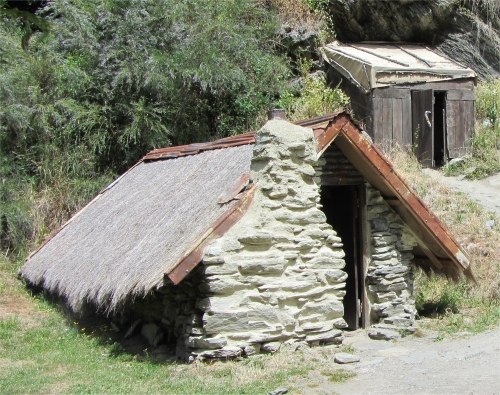
More Reconstructed Chinese Buildings
|
Between 1880 and 1900 the Chinese settlement had 16-20 permanent residents. The actual number would have fluctuated, especially in winter when miners were unable to work their claims. At first men may have shared huts, although in later years, when numbers had declined, residents tended to live alone.
Ah Lum's store was the Arrowtown Chinese Settlement's last store. When it closed after Ah Lum's death in 1925, so too did the heart of the Chine community.
In the evening I wandered down town and found a very small cinema down an alleyway. Tonight at a convenient time was a screening of The Iron Lady. Ideal I thought as a light shower engulfed me. It really was a small cinema, so small that there were individual tables where you could sip wine and tackle a cheese board at your leisure. This was sheer decadence and I decided to go for it. "Sorry, but we are all sold out tonight. It's because of the weather." Damn and blast, there goes the story of my life.
Further down the main street, the one and only main street, I came across a micro-brewery down another alleyway. Here I sampled one of the brews, an excellent beer I might add. It was crowded, and I found out from a guy who was also ordering at the bar that there was the follow on from a wedding party present. He came from Cambridge, two hours south of Auckland, the "town of trees" he said. I asked why. "The town likes to preserve trees," was his succinct answer. Over the course of the evening, as he returned to the bar, we bought each other drinks. He had done several OE trips to the UK, and had travelled extensively in the country. He had also spent three years in Holland, which he found awesome. He had made a serious effort to learn Dutch, but since everybody replied in English, he gave up.
A guy my age kept wandering through the bar, dressed in a white set of overalls. I deduced he was the brewer. "Any chance of a look around your brewery?" I asked. "Certainly," he replied, and soon I was among a gathering of stainless steel tanks. He opened up an IPA tank that was still fermenting and took out a measure. He poured himself a small glass, and one for me, and proceeded to do a specific gravity test on the remainder of the liquid. "Not quite ready yet," he pronounced. "I keep the slops and distil them to make pure alcohol. I use that to sterilise a lot of my equipment," he said. "It is legal in New Zealand to operate a still," he added. He took me to a back room where he kept his sacks of various malts from New Zealand, and also one from Castleford, UK. He ran through the whole fermentation process for me, and it was quite fascinating. I had also noticed he was selling a cherry beer. "There is a lot of fruit discarded around here, and I was given sacks full of cherries, so I tried making a cherry beer. I left it fermenting for a bit too long, but it still sells," he told me.
.
"Do you ever organise beer festivals here?" I asked. "We do have them in New Zealand, though not to the scale of those in Europe," he replied. "I would like to organise an outdoor one here, but of course we are dependent on the weather. I did visit one where it was very well organised, with a vast variety of food, drink and seven bands, and it cost the organisers nothing. They told the bands play for free and you can have as much food and beer as you want. For the food people they told them they could have all the drink and music for free, and so on. It went like a dream.
He had been an engineer in a previous life, and was able and keen to brew his own whiskey. What got him thinking was a Scottish chap living in the area, who had been a tester of Scottish whiskies, and was a recognised consultant. The Scottish chap reckoned the quality of the water was spot on and he could make a go of it. Now all he needed was ten or so multimillionaires who could each invest a million dollars to get a return in five or so years' time. A big, daunting gamble. I recommended he do a dry run and produce perhaps a hundred gallons and convince the investors.
His bar was closing for the night, so I left him pondering on that one.

